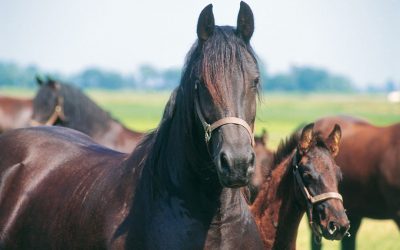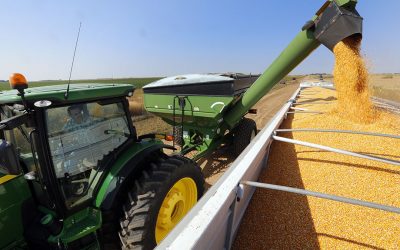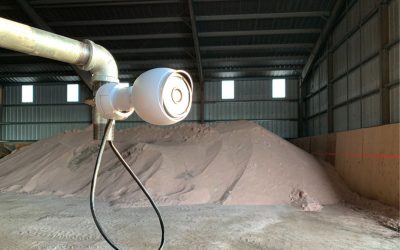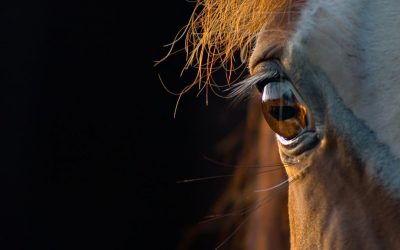Equine nutrition in the 21st century
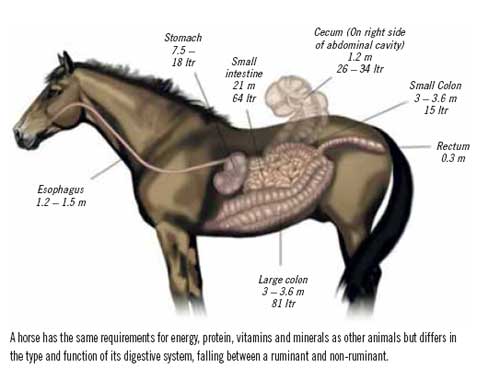
The science of equine nutrition is very different today than it was only a short time ago. As we learn more about how horses digest and utilise nutrients from feeds, and as more feeds become available, our feed choices broaden and change. Digestibility of a feed is almost as important as its nutrient content. Many new feeds from the human food manufacturing industry have entered the animal feed chain and also the horse feed sector.
By Judith A. Reynolds, Equine nutritionist; Equine product and technical manager, ADM Alliance Nutrition, USA
Horses are grazing animals with digestive tracts best suited for eating forages for 15-20 hours per day. They have relatively small stomachs, which hold only about five litres. The actual physical capacity of the stomach is larger, but the equine stomach begins to empty when it is only two-thirds full. Feed proceeds from the stomach through the small intestine, where most of the starch, sugar, fat, vitamins and minerals and about half of the protein from the feed should be digested and absorbed into the bloodstream. The remaining nutrients and the plant fibres continue on to the hindgut.
Horses have huge fermentation vats in the hindgut that hold 85-115 litres of fibrous material while billions of bacteria and other organisms work to digest it. Fibre-digesting bacteria produce volatile fatty acids (VFA) that are used by bacteria and horses for energy. In fact, horses on total forage diets receive 70% of their energy from these VFAs. Some of the remaining protein and some minerals, especially phosphorus, are absorbed from the large intestine, along with water, which is recycled within the body. Bacteria in a healthy horse’s hindgut also produce B-vitamins that can be used by the horse.
Grass and hay are the natural feed for horses due to the structure and shape of the equine digestive tract. Forages should be used to provide as much as possible of the three nutrients (dry matter basis) needed in the largest quantities; energy, protein and fibre or bulk. Forages are extremely variable in vitamin and mineral content and should not be relied upon to meet the total needs for those nutrients. In a recent study, mature geldings on pasture voluntarily consumed 3.3% of their body weight in dry matter from pasture, or around 50 kg of pasture grass (as fed basis), per day. The capability of horses to digest and utilise forage for energy has been seriously underestimated in the past, leading to boredom and the associated vices in horses.
Efficient but sensitive digestion
The equine digestive system is very efficient if horses are fed mainly grass or hay. But, if we feed too much grain in meals, the system doesn’t work very well. The high starch content in the grains is difficult to digest for a horse in the small intestine, because the animal doesn’t have enough enzymes or the starch is too compact to be broken down. And there is not enough time, because most feed goes from the mouth through the foregut and into the hindgut in less than six hours.
Starch entering the hindgut is used by starch-digesting bacteria to produce lactic acid. The addition of lactic acid to the hindgut results in a lowering of hindgut pH. Many of the beneficial, fibre-digesting bacteria cannot tolerate the more acidic conditions, so they die and release toxins into the hindgut. The presence of these toxins often results in colic and founder. Research results show that feeding 2.5 kg or less of grain-based feeds daily greatly reduces the risk of colic and founder in horses.
Energy needs
Horses need a certain amount of energy-producing nutrients from their rations, but hays and pasture can and should provide most of that energy. In fact, of the four categories of horse feeds, grains are a poor second to fats and provide only slightly more energy per unit than fermentable fibres (like soybean hulls and beet pulp) and good-quality hays. Grains supply only 35% as much energy as fats, 108% as much as fermentable fibres and 128% as much as good-quality hays. However, corn and barley provide even less energy when they are not processed, due to their low pre-caecal starch digestibility.A horse ration should start with forage. This means pasture or at least 10 kg of good-quality hay every day for an average-sized mature horse. Then vitamins, minerals, fats and limited amounts of grains (up to 2.5 kg/day) should be added as needed. Fats and oils can be fed at up to 10% of the total ration. Horses fed fats are less likely to suffer from digestive and metabolic disorders than with grains. Vegetable oils (corn, soybean) and food-grade stabilised rice bran (20% fat) are efficiently digested by horses and are excellent sources of energy. Oils are easier to digest when supplied as part of a grain mix or pelleted feed than when top-dressed over feed. Stabilised rice bran is very digestible and can be top-dressed or mixed into grains or pelleted feeds.Modern feeds contain added fat and digestible fibre, so they have less grain and starch than older formulas contained. For example, some feeds with varying fat, digestible fibre and starch concentrations are contained in Table 1.
What cereal to choose
Grains are very palatable to horses and have been used as high-energy feeds throughout recent history. All have different energy, protein and fat contents (Table 2). Oats are the traditional cereal grain for horses and are the best choice for several reasons. Oats are very palatable and are the best nutrient-balanced grain. Most importantly, the starch in oats is easily digested (83%) by enzymes in the foregut (Table 3). Therefore, oat starch doesn’t contribute to starch overload in the hindgut like corn and barley starches do. However, horses fed oats will have increased blood sugar at about 1½ – 3 hours after the meal, followed by decreased blood sugar. This effect is similar to that seen in people eating high starch or sugary foods. Some horses are very sensitive to increased blood sugar, and exhibit a “grain-high” attitude, which can interfere with its training and performance schedule. Also, oats tend to be high-priced for the nutrients they provide. Oats should be clean, but don’t need to be processed, except for horses with poor teeth (very young, sick or old horses). Corn sometimes has a bad reputation as a horse feed, for good reasons. Corn is more energy dense and heavier than oats, so a direct can-for-can substitution of corn for oats will lead to overfeeding. Corn is not balanced for nutrients, containing only about 2% fibre, and as mentioned earlier, most of the starch in corn is not digested in the foregut (unless the corn is ground and pelleted or extruded) leading to digestive problems. Therefore, corn should be processed for all horses, and it should not be more than 25% of a pelleted feed. Barley (65% starch) has a hard kernel that horses cannot easily chew, so it is usually rolled. However, even in rolled barley, the starch has a low pre-caecal digestibility (about 21%) in horses. Therefore, oats are a much better choice for horses than barley.
Grain mixes and fortified feeds
Grain mixes contain grains and molasses, but not added vitamins and minerals. They always contain more phosphorus than calcium and usually lead to nutrient deficiencies and imbalances in the total ration.
Fortified feeds are very popular, because they contain vitamins and minerals in the correct amounts and ratios for horses. Fortified feeds come in two main forms, sweet feeds and pelleted feeds. Sweet feeds come in all formulas and are the number-one choice of horse owners and horses, but they are detrimental in several ways. The molasses is rapidly turned to sugar in the foregut, contributing to an increase in blood sugar or “sugar high” that can interfere with performance ability. Also, feeds containing molasses are eaten more quickly by horses, resulting in lower digestibility of the feed. Besides, sweet feeds have a short shelf-life, cake badly in the winter, attract flies in the summer and are expensive for the nutrients they provide. Small amounts of sweet feeds are good carriers for medications and supplements. And, they might improve the palatability of other feeds.
Pelleted feeds also come in many formulas. When made by a reputable company, they will contain high-quality feeds and by-products from the food industry. Many components of pellets are more digestible due to processing. And, pelleted feeds usually have a longer shelf-life, are less messy to handle and are more economical for the nutrients they provide than sweet feeds.
Whether using sweet feed or pelleted feed, it should contain at least 10% fibre and, preferably 13-14% fibre. The fibre should be from highly digestible sources such as soybean hulls, beet pulp or alfalfa. Straw or rice hulls are not recommended.
Fibre-to-energy relationship
New information on foregut digestibility of grains proves that we cannot use the older values for digestible energy (DE) with horses. Research showed that corn-starch fermented in the hindgut of horses produces only about 75% or less of the DE of corn-starch digested in the foregut. And, starch in the hindgut also affects fibre digestibility, further reducing the useable DE of the total ration (Table 4). Fibre is a prerequisite in the digestive process. Feed progresses through the foregut of horses without much mixing. It often remains in the stomach for less than an hour, so the grain fed at 7 am doesn’t mix well with the hay the horse eats from 7:30 to 9:00 am. Therefore, all of the feed the horse eats, including the grain or concentrate portion, should contain sufficient fibre to move it along the tract normally.
In modern horse feeds crude fibre content no longer accurately predicts DE. We can use fats for concentrated energy and fermentable fibres, like soybean hulls and beet pulp, to increase the fibre content of horse feeds, making them safer for horses, yet powerful enough to fuel even the most elite athletes. Of course, indigestible fibres like oat hulls, peanut hulls, rice hulls and straw provide fibre, which helps keep the foregut functioning properly. But they do not ‘feed’ the hind-gut bacteria or provide energy for the horse.
It is time to retire the old fibre and DE table and start feeding our horses like the grazing, fibre-digesters they are. I recommend concentrates made with digestible fibre, which are available in all desired energy levels for horses. There is now a high-fibre feed available for every horse, from the ‘easy keeper’ to the race or endurance horse.
Reprinted with permission from ADM Alliance Nutrition, Inc., Quincy, Illinois, USA. www.admani.com. “Equine Nutrition in the 21st Century” is a summary of numerous equine nutrition articles available for viewing on ADM Alliance Nutrition’s equine website: www.grostrong.com




